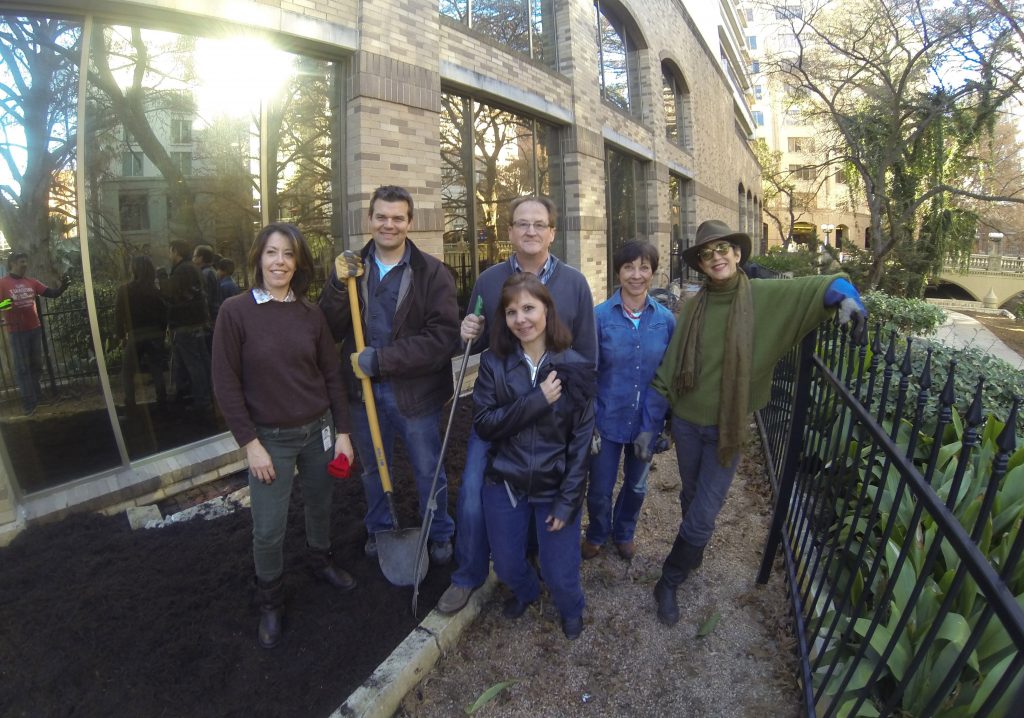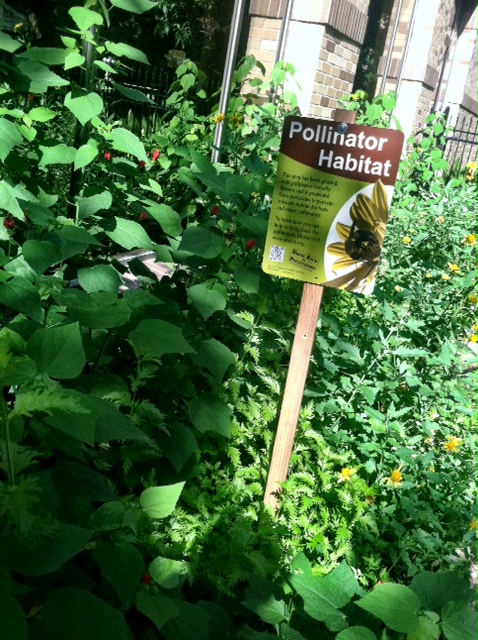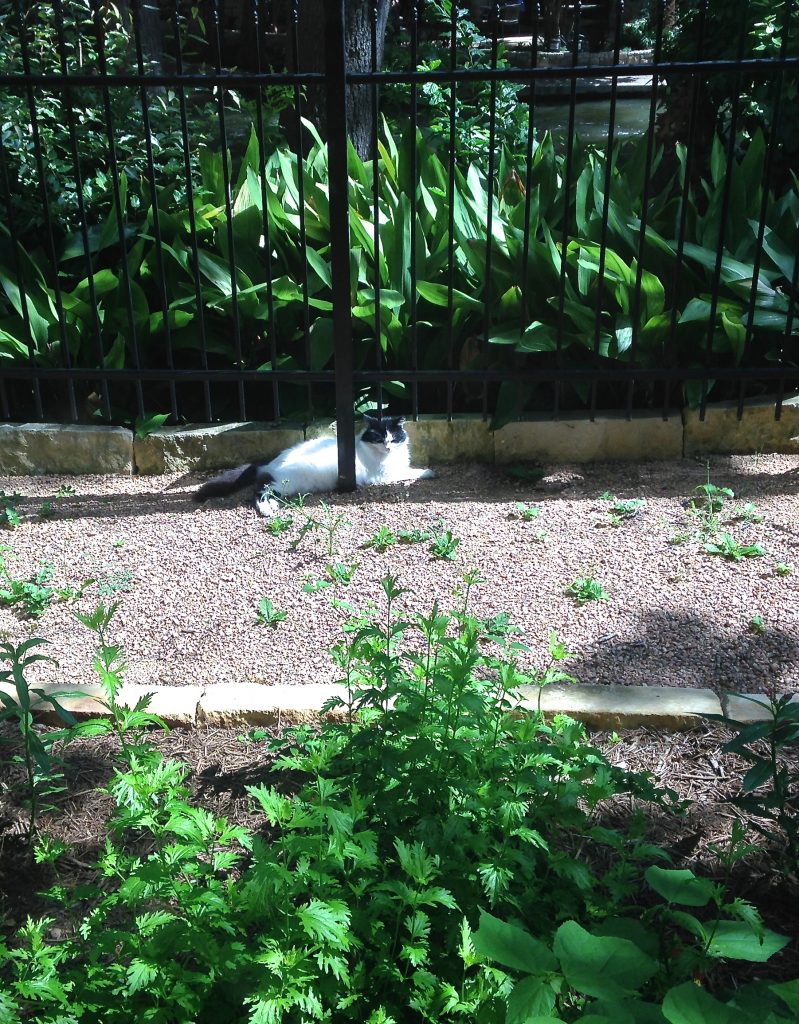In my day job at CPS Energy, the largest municipally owned electric and gas utility in the country, I look out my window onto the glorious San Antonio River Walk.

CPS Energy Pollinator Posse, L- R: Stephanie Ockenfels, Sam Taylor, Vincent McDonald, Pamela Maris, Gwenn Young, Monika Maeckle Photo by Gary Chavez
When I joined the company last year, a homogenous, overgrown patch of iron plant, occupied the small, triangular garden that separates my office from the San Antonio River. My view includes locals mingling with tourists and badge-wearing conventioneers shuffling along the sidewalk en route to hotels or meetings under the shade of grand Bald Cypress trees. Until recently, not many insects or pollinators joined the party.

Pollinators and other creatures have gravitated to the small plot at CPS Energy. Photo by Vincent McDonald
When I accepted the position as director of integrated communications, I joked with friends that my not-so-secret agenda would be “pollinator corridors under power lines.” I wasn’t kidding. We’re working on that.
In the meantime, however, I wondered: would it be possible to transform this small corner of the River Walk into a more interesting view for me and my colleagues while offering a more inviting habitat for local critters, especially pollinators?
The area sees mostly shade, which is why landscapers planted Aspidistra elatior. Commonly known as iron plant, or cast iron plant, this well-adapted evergreen has a reputation for its resistance to neglect. It thrives in shade and requires little water.
Flowers need sun and pollinators need flowers. Dappled light finds its way to this plot in the mornings and cascades from the west in the afternoon. That’s enough for certain plants to flower. If we chose our plants carefully, we might be able to lure butterflies or hummingbirds. Hmmm.

AFTER: Pollinators and other creatures have gravitated to the small plot at CPS Energy. Photo by Vincent McDonald
In January, volunteers from our corporate communications team joined me in a small “Pollinator Power” experiment. A half-dozen willing workers gathered late one cool winter afternoon to tackle the transformation of the 120-square foot plot into a pollinator habitat.
We used my favorite low-tech method of clearing undesirable plants: hand pulling (thank you, CPS Energy landscape crew!) followed by solarization, an environmentally friendly method for ridding soil of pests, pathogens and undesirable plants executed by my corp comm colleagues.
On January 3, we laid six-10 layers of newspaper atop the soil after the CPS Energy landscape crew hand-pulled the iron plant. We then watered the newspaper, applied four-six inches of compost and mulch, spreading it evenly.

Sorry, kitty. No milk, but would you settle for some milkweed? “Polly” the cat visits the CPS Energy pollinator garden. Photo by Monika Maeckle
Then, we waited. Solar power does the rest. By blocking light with the newspaper and mulch mix and using the sun’s energy to kill pathogens and weed seed, we prevent the growth and spread of undesirables.
About eight weeks later, we plugged in specific shade tolerant plants by simply carving a small hole into the mulch and newspaper with a shovel. Plant choices were dictated by their appeal to pollinators as either host plants (where they lay their eggs) or nectar plants (which they use for fuel), and an ability to thrive in dappled sun.
These are the plants we chose and why.
Turk’s Cap Malvaviscus arboreu
Hummingbirds love this shade tolerant member of the mallow family, which blooms red.
Milkweed Asclepias curassavica, Asclepias incarnata
Host plant to Monarch and Queen butterflies. These prolific bloomers work as nectar magnets for all butterflies.
Gregg’s Purple Mist flower Conoclinium greggii
Male Queens crave this plant’s purple bloom, which provides them special nutrients that make them attractive to the lady butterflies.
Yellow Texas Columbine Aquilegia hinckleyana
Another hummingbird favorite, the delicate leaves of this shade tolerant plant cradle interesting yellow blooms.
Texas gold lantana Lantana urticoides
Excellent all-around nectar plant. Hearty, drought tolerant, reliable bloomer in orange or yellow.
Cowpen Daisy Verbesina encelioides
A personal favorite. This member of the sunflower family blooms nonstop, works overtime as a nectar source and as a host to the Bordered Patch butterfly.
Jimsonweed Datura wrighti
Host plant to the Sphinx moth, the robust grower loves the heat, shows large white flowers in the evening, and has a fantastic fragrance. The leaves smell like chocolate–but don’t eat them. They cause hallucinations.
After planting, we watered each plant thoroughly and tossed a handful of slow-release fertilizer into the soil around the plant base.
In May, as the weather warmed, we developed a volunteer watering schedule, dubbed our “Pollinator Posse.” Several corporate communications staff agreed to water with a hose three times a week.

A pair of Mallard ducks took up residence in the pollinator garden at CPS Energy. Photo by Lori Johnson
Several staff members commented that the 10-minute watering break in the dappled shade of the pollinator garden was “the most relaxing part of the day.”
In June, we sent off for our official Xerces Society sign, designating our plot as pollinator habitat, and now here we are in August, the most brutal month of the year, and the pollinator garden is thriving.
So far, we’ve witnessed visits from Queen and Sulphur butterflies, watched a black-chinned hummingbird sip from a Turk’s cap bloom, and enjoyed a pair of mallard ducks who built a temporary shelter in the garden. A downtown kitty-cat visits from across the street at La Villita, the old Mexican market. She lies in the shade and watches the pollinators busy themselves on the blooms. Imagine what kind of wildlife is visiting when we’re not looking.

A pair of Mallard ducks took up residence in the pollinator garden at CPS Energy. Photo by Lori Johnson
We’ve also had extended visits by a juvenile Golden-crowned Heron, who has decided the insects who’ve taken up residence in the garden make for tasty morning snacks. This bird was quite comfortable at our plot, lingering long enough for us to snap multiple photos.
I would offer that for those of us with a window view–and for passersby and nearby urban wildlife–our pollinator power experiment has been a success.
We haven’t seen any Monarch butterflies. Yet. But we’re keeping our fingers crossed as the fall migration gets underway later this month. Hopefully they’ll recharge at CPS Energy before making their way to Mexico. You’ll read about it right here when they do.
UPDATE: In a previous version, iron plant was misidentified as hostas. Hostas and iron plant are in the same family but different genera. Thanks to reader Anna Osborn for pointing out the faulty I.D.
- Mostly Native Urban Butterfly Garden Outperforms Grass Every Time
- Converting Ugly, Dead Grass to a Butterfly Garden
- How to Get Native Milkweed Seeds to Germinate
- Tropical Milkweed: To Plant it or Not is No Simple Question
- Desperately seeking MIlkweed: Be sure to buy pesticide free plants
- Butterfly FAQ: Is it OK to Move a Chrysalis? Yes, and here’s how to do it
- How to Make Seedballs
- Converting your Lawn to a Butterfly Garden


What a beautiful garden! And I really like the idea of pollinator habitats under power lines. Also great that passers-by will see the Xerces sign and understand it’s not just any garden.
About the cat and the birds — I’m wondering if that’s a good mix, for the birds that is. Cats have a tendency to kill birds. I would worry about the ducks especially, since they’re “sitting ducks” for a cat.
Thanks, Ruth. The shopkeepers at La Villita keep Polly cat’s bowl full of food, so I’m not too worried about the birds. Thanks for writing.
Great work and huge improvement. Cast iron plants, however, are not hostas. Cast iron plants are aspidistra elatior. There are many (at least 45) different species of hosta and they are widely used as shade plants. (see internet) Cast iron plants are recommended as shade plants for areas such as Florida but by observation they do not do well here and suffer browning of the leaves. Please do not confuse with hosta which is a lovely plant, and while they do bloom are not great plants for pollinators. Again, good work, but please do your homework.
Anne, thank you for writing. Not sure which we have here, will do some more research.
Excellent job!!! And the wildlife is thanking you with their visits.
I’ve always looked at those long spaces under the power lines and wished they could be put to native plant use for wildlife, but I thought they were heavily drenched with herbicides for easy access for equipment maintenance. By all means, please convert them into wildscape corridors!
Working on it!
You are such an inspiration, Monika. Bravo for you and your beautiful efforts!
Hi Monica
I had a nice surprise today & that was I found three Monrachs on my milk week this afternoon. I haven’t the slightest idea when they were laided because the only butterfly I saw was a male or so I thought!!
Nice job keep up the good work!!
Wonderful idea… When we turned our SC yard into an urban wildlife habitat our neighbors had a fit … Hedgerows, woodpiles , food bearing plants all offended their Grass is Beautiful mindset. An official sign made all the difference. I have also had to share articles on low water gardening with our insurance company. It takes time to change the world…
Yes, Donna, this is a common problem. Folks are locked in to a specific idea of beauty and it often does not include plants going to seed. More education needed.
I would actually very much worry about the cat, fed or not. We have a neutered, fat cat who loves nothing more than to get out and kill birds and squirrels for no good reason other than instinct! It’s work to keep him from getting out 🤦🏻♀️